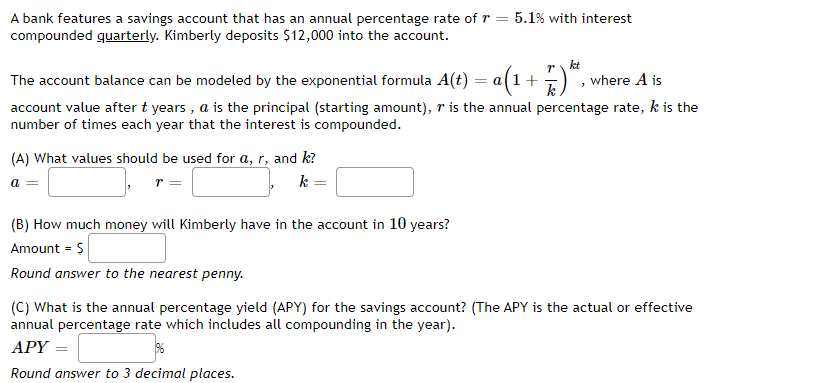A bank features a savings account that has an annual percentage rate of r = 5.1% with interest compounded quarterly. Kimberly deposits $12,000 into the account. The account balance can be modeled by the exponential formula A(t) = a(1+ kt where A is account value after t years , a is the principal (starting amount), r is the annual percentage rate, k is the number of times each year that the interest is compounded. (A) What values should be used for a, r, and k? k = (B) How much money will Kimberly have in the account in 10 years? Amount = $ Round answer to the nearest penny. (C) What is the annual percentage yield (APY) for the savings account? (The APY is the actual or effective annual percentage rate which includes all compounding in the year). APY Round answer to 3 decimal places.
A bank features a savings account that has an annual percentage rate of r = 5.1% with interest compounded quarterly. Kimberly deposits $12,000 into the account. The account balance can be modeled by the exponential formula A(t) = a(1+ kt where A is account value after t years , a is the principal (starting amount), r is the annual percentage rate, k is the number of times each year that the interest is compounded. (A) What values should be used for a, r, and k? k = (B) How much money will Kimberly have in the account in 10 years? Amount = $ Round answer to the nearest penny. (C) What is the annual percentage yield (APY) for the savings account? (The APY is the actual or effective annual percentage rate which includes all compounding in the year). APY Round answer to 3 decimal places.
Cornerstones of Financial Accounting
4th Edition
ISBN:9781337690881
Author:Jay Rich, Jeff Jones
Publisher:Jay Rich, Jeff Jones
ChapterA3: Time Value Of Money
Section: Chapter Questions
Problem 21E
Related questions
Question

Transcribed Image Text:A bank features a savings account that has an annual percentage rate of r = 5.1% with interest
compounded quarterly. Kimberly deposits $12,000 into the account.
The account balance can be modeled by the exponential formula A(t) = a(1+
r kt
where A is
account value after t years , a is the principal (starting amount), r is the annual percentage rate, k is the
number of times each year that the interest is compounded.
(A) What values should be used for a, r, and k?
k =
= D
(B) How much money will Kimberly have in the account in 10 years?
Amount = $
Round answer to the nearest penny.
(C) What is the annual percentage yield (APY) for the savings account? (The APY is the actual or effective
annual percentage rate which includes all compounding in the year).
АРY
Round answer to 3 decimal places.
Expert Solution
This question has been solved!
Explore an expertly crafted, step-by-step solution for a thorough understanding of key concepts.
This is a popular solution!
Trending now
This is a popular solution!
Step by step
Solved in 5 steps

Knowledge Booster
Learn more about
Need a deep-dive on the concept behind this application? Look no further. Learn more about this topic, finance and related others by exploring similar questions and additional content below.Recommended textbooks for you

Cornerstones of Financial Accounting
Accounting
ISBN:
9781337690881
Author:
Jay Rich, Jeff Jones
Publisher:
Cengage Learning

EBK CONTEMPORARY FINANCIAL MANAGEMENT
Finance
ISBN:
9781337514835
Author:
MOYER
Publisher:
CENGAGE LEARNING - CONSIGNMENT

Principles of Accounting Volume 2
Accounting
ISBN:
9781947172609
Author:
OpenStax
Publisher:
OpenStax College

Cornerstones of Financial Accounting
Accounting
ISBN:
9781337690881
Author:
Jay Rich, Jeff Jones
Publisher:
Cengage Learning

EBK CONTEMPORARY FINANCIAL MANAGEMENT
Finance
ISBN:
9781337514835
Author:
MOYER
Publisher:
CENGAGE LEARNING - CONSIGNMENT

Principles of Accounting Volume 2
Accounting
ISBN:
9781947172609
Author:
OpenStax
Publisher:
OpenStax College


Financial Accounting: The Impact on Decision Make…
Accounting
ISBN:
9781305654174
Author:
Gary A. Porter, Curtis L. Norton
Publisher:
Cengage Learning

Intermediate Accounting: Reporting And Analysis
Accounting
ISBN:
9781337788281
Author:
James M. Wahlen, Jefferson P. Jones, Donald Pagach
Publisher:
Cengage Learning